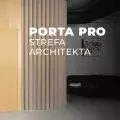Work submitted for the competition
"Best Diploma Architecture"
The presented thesis deals with the subject of sensory interactions in the space of the urban fabric and related aspects of the impact of urban composition elements on the quality of human life in the city.
masterplan
© Michal Ruman
"First we shape our buildings, and then they shape us" — these are the words of prominent British politician Winston Churchill. Every spatial form created by an architect stimulates our senses and affects the behavior and emotions of users. The relationship linking man and architecture is based on the stimuli generated by the surrounding space, and the channels of communication between architecture and man are all available human senses, as Juhani Pallasmaa notes in his book "The Eyes of the Skin". A particular strand of research into the connections between architecture and the senses is proxemics, a branch of psychological science that studies the dependence of material space and its influence on human perception. Proxemics describes the perception of space as the process of learning about a city through available receptors and then encoding its image in consciousness. In psychology, this process is called sensory integration. The psyche segregates, recognizes, interprets and combines memories and experiences received from all the senses, thus providing information about the surrounding space and creating certain positive or negative perceptions about it. Thus, sensorimotorism can be described as a kind of cognitive mechanism that creates particular ideas about the urban fabric. Importantly, the mechanism has a feedback character, a person first creates an architectural space that reflects our emotions and determines future behavior, for example, subsequent creative processes.
analysis of individual elements of the premise
© Michal Ruman
"First we shape cities, then they shape us". Danish urban planner Jan Gehl, paraphrasing the British politician's statement, brings considerations of sensorium to the urban scale. In their research work, urban planners Kevin Lynch and Kazimierz Wejchert identify the types of structures that most strongly affect the human psyche, as well as characterize their form and define the relationships that occur between them.
They classify the main elements of urban composition, namely: paths, edges, districts, nodes, landmarks. Urban planners shape the urban fabric using this set of tools. Of those listed, the dominant feature has the strongest impact on the user. The purpose of this element is to crystallize the layout by organizing its various parts. This influences clearer perception and identification.
site plan
© Michal Ruman
Considering this issue, the paper attempts to outline a new development direction for the spatial dominant. An authorial element of the urban composition is created, i.e. the centroid dominant. It takes the form of a large-scale assumption with unique characteristics intended to influence the user, thus becoming a dominant composition element in the entire urban system.
Design of a multifunctional urban establishment in Warsaw
© Michal Ruman
Degraded areas and areas separated from the city's spatial layout are proposed as potential areas for the location of centerpiece dominants. These areas require multifaceted regeneration, including improvement of the quality of public space and implementation of diverse functions. A contemporary dominant should represent timeless values, build the identity of the place and create a special character, constitute a cultural and social symbol. A centripetal dominant is intended to introduce spatial order and create a high quality of life. With its spatial and ideological message, it is supposed to attract all the senses, provide aesthetic experiences, strengthen the user's relationship with the city and foster bonds and interpersonal contacts. This urban form is likely to create a kind of field of sensory and spatial interactions.
A project for a multifunctional urban planning complex in Warsaw
© Michal Ruman
The work presented here emphasizes the importance of shaping a sensual urban fabric conducive to creating social connections, stimulating local activity and building a city's identity. If cities in the future will become the main environment of human life, it is important that they meet functional needs, but special attention should also be paid to the way they affect the human psyche, to be able to provide users with the best possible living conditions and experiences.
The design of a multifunctional urban development in Warsaw
© Michal Ruman
Michal RUMAN
Illustrations: © Author





















































